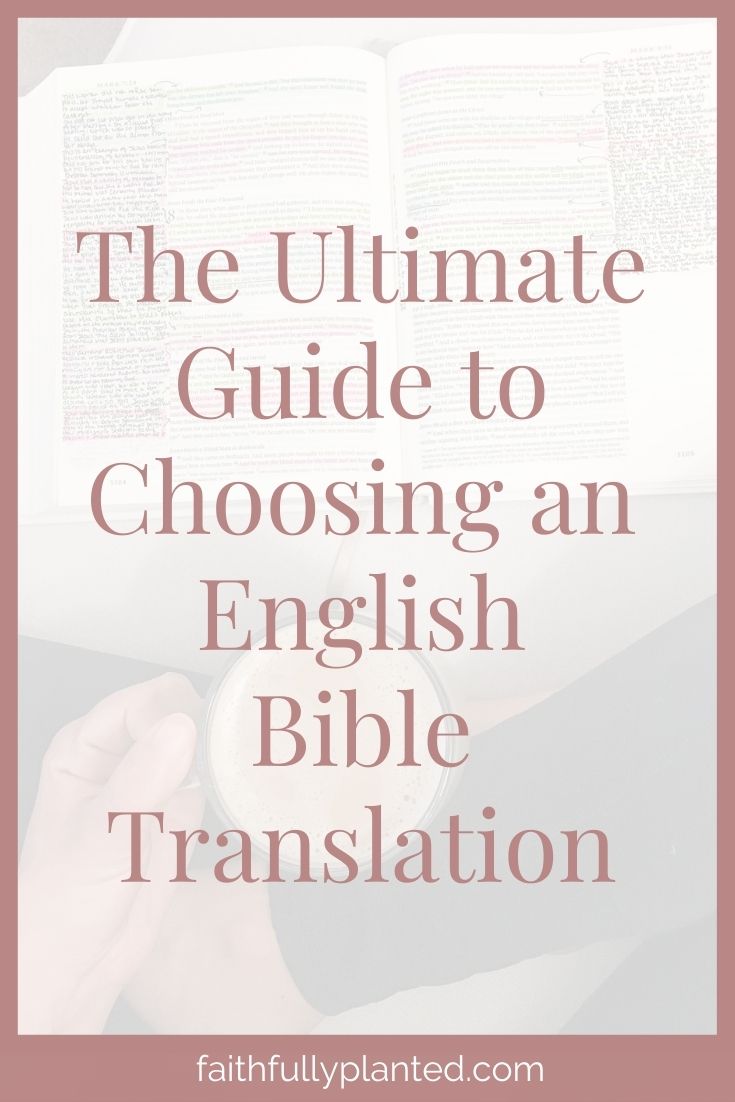How to Choose the Best Bible Translation: Your Ultimate Guide

Choosing the Right Bible Translation for You
Choosing the right Bible translation can feel overwhelming. With so many options—each claiming to be the most accurate or the easiest to read—how do you know which one is best for you? If you’ve ever wondered whether you’re reading the ‘right’ Bible, you’re not alone.
With so many options and so much misinformation about Bible translations out there, it can be easy to get overwhelmed. Most of us want to be sure we are picking the most accurate bible translation while also being able to read and understand it.
That’s a tall order even for seasoned Christians.
Choosing a reliable, accurate translation that you can actually read is a vital component of your faith journey. The first step in being able to know God through His Word is being able to read and understand it.
I hope that this in-depth post will help you to feel confident in your choice of Bible translation.
We will cover everything from the history of the Bible, to how it is translated and I also include my personal recommendation for choosing a Bible translation.

The History of Bible Translation
For centuries, the Bible has been translated into hundreds of languages, including the English versions we read today. However, the process of translation is more complex than most people realize.
The Old Testament was originally written in Hebrew and the New Testament was originally written in Greek. Not only that but ancient iterations of those languages.
Along with originally being written in ancient languages, parts of our modern Bible were written hundreds of years apart. While we have a cohesive Bible today, it did not always exist in that format.
The Bible was also was not nearly as accessible as it is today. In ancient times, only those who spoke those languages could read Scripture. For most of history, literacy was a luxury.
Eventually, those Scriptures were translated into Latin to allow more accessibility. In those times, specially trained men called scribes translated the Scriptures entirely by hand.
This process was laborious and expensive, so Bibles were only in churches and handled by appointed priests.
There was no access to Scripture by the general public outside of the church such as we have today.
The First English Translations
The fight to make the Bible accessible to everyday people came at a great cost.
In the 1300s, John Wycliffe defied religious authorities by translating the Latin Bible into Middle English, believing that Scripture should be available to all. His work was so controversial that years after his death, the church dug up his remains and burned them as a heretic.
His contemporary, Jon Huss, preached that the Word of God should be in the hands of the people. For this, he was burned at the stake. Yet their sacrifices paved the way for the explosion of Bible translations that followed during the Reformation.
If you want to dig deeper into the history of Bible translation, here is a wonderful essay by Daniel B. Wallace. You can also find a detailed timeline of the history of the Bible here.
How is the Bible translated?
So, how do we get from ancient Hebrew and Greek to the English Bibles we read today? Understanding the translation process is key to choosing the best Bible for you.
It is generally done by a group of people, rather than a single person, and begins with a deep study of the original language being translated.
There are 2 major kinds of translation theory:
- Word For Word
- Thought for Thought
Bible translations fall on a spectrum.
On one end, you have word-for-word translations (like the KJV, ESV, and NASB), which stay as close as possible to the original wording. On the other hand, you have thought-for-thought translations (like the NLT and CEV), which prioritize readability and clarity over exact wording. Some versions, like the NIV and CSB, aim for a balance between the two.
Word-For-Word translation, also known as “formal equivalence” translation, seeks to retain the syntax and structure of the original language.
Greek and Hebrew sentences don’t follow English grammar rules, which can make direct translations feel a little clunky. For example, a literal translation of Philippians 4:13 from Greek would read:
‘All things I have strength in the strengthening me.’
Obviously, that doesn’t flow well in English! That’s why translators work to balance accuracy with readability, ensuring you can understand the original meaning without losing its depth.
Word-for-word translations attempt to keep the original wording as closely as possible while also translating it into understandable English.
Many consider these translations to be the most “accurate” to the original language. The interlinear Bible, KJV, NKJV, NASB, ESV, RSV, and the NRSV are all examples of word-for-word translations.
Thought-For-Thought translation, or dynamic equivalence translation, seeks to communicate the intended thought from one language to another.
Its primary aim is to deliver the meaning of the Scriptures to the reader. “Functional equivalence” is another name for this type of translation.
Many consider these translations to be the easiest for modern English speakers to read. The NLT, CEV, NCB, and NJB are examples of thought-for-thought translations.
Translations such as the NIV, HCSB, and the CSB exist in the middle and utilize both translation philosophies to stay true to the original text while also prioritizing ease of understanding.
A Word on Bible Translation Paraphrases
There are also paraphrases of the Bible that are often referred to as translations, but these are not technically “translations.”
They operate on what is known as “free translation” theory, meaning they prioritize readability and translating ideas from one language to another. You might think this doesn’t sound like an issue, as who wouldn’t want the most readable option. However, free translation theory deviates so far from the original text that the intended meaning of the passage or verse can get lost or muddled.
These “translations” often add a lot of extra, unnecessary wording to the text.
Let’s compare a few verses.
Matthew 5:14-16 in the NIV reads,
“You are the light of the world. A town built on a hill cannot be hidden. Neither do people light a lamp and put it under a bowl. Instead, they put it on its stand, and it gives light to everyone in the house. In the same way, let your light shine before others, that they may see your good deeds and glorify your Father in heaven. “
In the Message version, it reads,
“Here’s another way to put it: You’re here to be light, bringing out the God-colors in the world. God is not a secret to be kept. We’re going public with this, as public as a city on a hill. If I make you light-bearers, you don’t think I’m going to hide you under a bucket, do you? I’m putting you on a light stand. Now that I’ve put you there on a hilltop, on a light stand—shine! Keep open house; be generous with your lives. By opening up to others, you’ll prompt people to open up with God, this generous Father in heaven.“
There is quite a bit of difference in these two passages, and in my opinion, the Message version is actually a lot less clear. With all the added wording, the intended meaning of the passage (to let your faith shine to bring glory to God) is muddled.
These types of translations are more meaning-for-meaning commentaries than translations, as they over-prioritize ease of reading rather than accuracy to the original language.
Bible paraphrases utilize modern idioms and topical wording that are not actually in the original texts to attempt to communicate the meaning of Scripture to the reader in the most modern way possible.
When it comes to paraphrases, be cautious.
These should not be your primary source of Scripture, as they are not as reliable as direct translations. It is very easy for opinion and bias to creep into paraphrases, as they are the “in the own words” of the paraphraser.
A lot of interpretation goes into creating a meaning-for-meaning paraphrase.
I personally do not read or utilize any paraphrases in my Bible study.
Why do some Bible translations seem to”omit” verses?
You may have noticed that some translations (like the NIV or ESV) either omit certain verses or include a note that says, ‘some manuscripts include…’
This isn’t because verses were ‘removed’—rather, scholars have discovered older, more reliable manuscripts (like the Dead Sea Scrolls) that don’t include these additions.
In earlier centuries, some scribes unintentionally added words for clarification while copying manuscripts. Modern translations aim to reflect what was originally written, not what was added later.
Rather than ‘removing’ verses, modern translations restore the Bible to what was originally written, before later additions were made. This means you can trust that your Bible today is actually closer to the original Scriptures than some older versions!
Why is there such variation from one Bible translation to another?
When we dig into all of the different translations, it can get overwhelming and spur more questions than answers.
Why are there so many? How did they get to be so different?
This is the difficulty with translating ancient languages into modern English. Translators run into issues of syntax, sentence structure, the changing meaning of words over time, gender bias, and a whole host of other hurdles that they must overcome to do that task of translating.
Essentially, every translation is an interpretation of the original language.
This is why doing the work to choose a reputable, reliable translation is so important for Bible study. Every translation is a work of interpretation and that will inform how you go on to understand Scripture.
Do Your Research
Before you decide on a translation (or 2) do a little background research.
Get recommendations from trusted sources, but then dig a little deeper before committing to that translation.
Some questions you might ask when researching a translation are:
- When was it translated?
- Has it been revised? Is this the older or newer version?
- Is it a thought-for-thought or word-for-word translation? Does it land somewhere in the middle?
- Who translated it? A group or a single person?
- Who reviewed it? Scholars or committees?
- What was the goal of the translation? Accuracy? Or understanding?
The most important thing to remember is that our English Bible is a translation. Unless you take the time to learn Biblical Hebrew and Greek, you will not be able to read it 100 percent accurately.
But that is okay.
The people God has entrusted to translate our Bibles do understand Hebrew and Greek and have studied those original languages. And we have the power of the Holy Spirit to help us discern and have wisdom when it comes to reading those translations.
So, which Bible translation is best?
At the end of the day, the best Bible translation is the one you’ll actually read.
Take time to explore different versions—maybe read the same passage in the ESV, NIV, and NLT to see how they compare. What translation do you currently use, and why? Let me know in the comments!
Your Sister In Christ,








This is a wonderful resource! I learned much of this when researching translations the last time I bought a Bible. I love that you’ve put all that into one resource. I’m going to add this post as a resource to my Tips for Reading the Bible post. 🙂
Thank you for all the great information!
Wow, what a great resource! Bookmarking this one.
I read ESV, CSB and NASB, but I also enjoy correlating the MSG because it was the first “Bible” that I was actually interested in reading. It was given to me when I became a believer and struggled with reading the Word and understanding it, also before I had any spiritual disciplines. I do believe the Lord can use it and that he inspires the process of creating those paraphrases for people like me, but definately, they should be used along side of a Word for Word. I didnt recieve the best discipleship in my personal opinion so I learned later on about the importance of Word for Word, and wish that would have been encouraged whenever they did hand out the MSG bibles at the conference I was at that year… Love this though, you’re awesome, love you. <3
It absolutely can be! It can be a great introduction to Scripture and a tool to get someone excited about the Bible. I would always caution against using it as a sole source. Thank you for sharing <3 You're more awesome. Love you friend.
Thanks for the great resources and your recommendation.
I love your website, however, the pale font color makes it difficult to read. I don’t mean to be critical but maybe helpful to others.